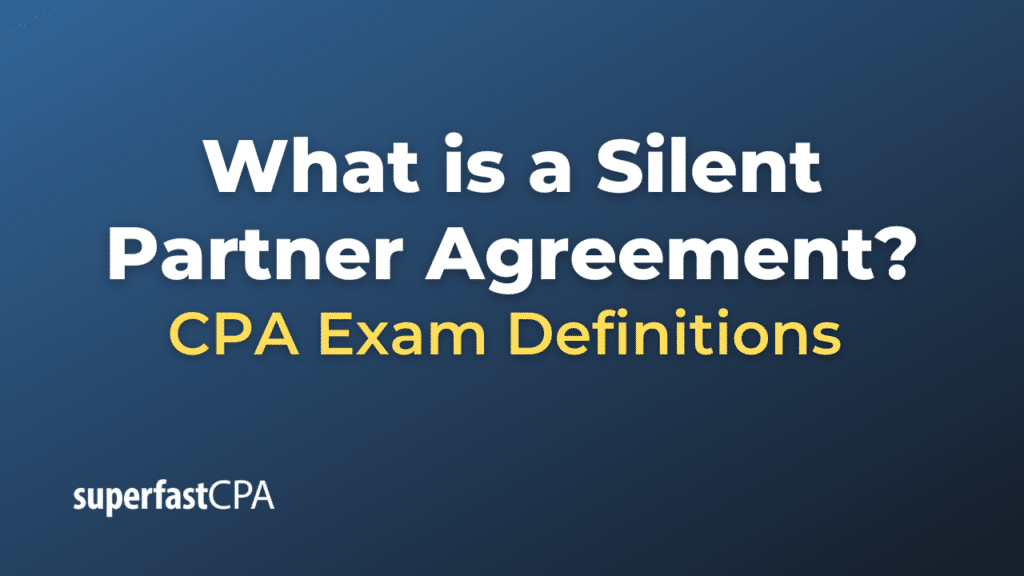Silent Partner Agreement
A silent partner agreement is a formal arrangement between partners in a business where one partner (the silent partner) provides capital investment but does not participate in the day-to-day operations or management decisions of the business. This partner remains “silent” in terms of management and operational involvement. The primary role of a silent partner is to contribute capital, and in return, they receive a share of the profits or losses of the business.
A silent partner agreement typically outlines the following key points:
- Capital Contribution: The amount of money or assets the silent partner is contributing to the business.
- Profit and Loss Sharing: The percentage of profits or losses the silent partner is entitled to, which may or may not correspond directly to their percentage of ownership.
- Involvement in Management: This section will specify that the silent partner will not be involved in the daily operations or management decisions of the business.
- Liability: Depending on the structure of the business (e.g., a limited partnership), the agreement may outline that the silent partner’s liability is limited to their investment in the business. This means they cannot be held responsible for business debts or liabilities beyond their initial investment.
- Termination or Exit Strategy: The conditions under which the silent partner can exit the partnership or under which their involvement can be terminated. This might include selling their stake, conditions for dissolution of the partnership, or procedures in the event of a disagreement between partners.
- Dispute Resolution: Specifies how disputes between the partners will be resolved, often pointing to mediation or arbitration as preferred methods before legal action.
- Confidentiality: Since the silent partner will have knowledge about the business’s finances and operations, there might be clauses preventing them from disclosing sensitive information.
- Duration of the Agreement: Specifies the period the agreement covers and conditions for renewal.
Example of a Silent Partner Agreement
Let’s delve into a hypothetical silent partner agreement scenario to illustrate the concept.
Scenario: Java Bliss Café
Entities Involved:
- Emma: An experienced barista and coffee enthusiast with a dream of opening her own café but lacks the necessary funds.
- Jake: A wealthy individual interested in investing in profitable ventures but has no experience or interest in the food and beverage industry.
The Agreement:
- Capital Contribution: Jake agrees to invest $150,000 into Emma’s dream café. This contribution will cover leasing a location, renovating the space, purchasing equipment, initial inventory, and operational expenses for the first few months.
- Profit and Loss Sharing: In return for his investment, Jake will receive 40% of the café’s net profits. Any losses incurred by the café will also reduce his capital account by this same percentage.
- Involvement in Management: The agreement specifies that Jake will have no role in the day-to-day operations, management decisions, or any other aspect of the café’s running. Emma will be entirely responsible for all operational aspects.
- Liability: The café is structured as a limited partnership, which means Jake’s liability is restricted to his initial investment. If the café accrues debts beyond its assets, Jake cannot be pursued personally for those debts beyond his $150,000 investment.
- Termination or Exit Strategy: The agreement states that after five years, Jake has the option to sell his share back to Emma at a predetermined formula or find a buyer for his share. Emma has the right of first refusal in any sale.
- Dispute Resolution: Any disagreements or disputes between Emma and Jake will first be addressed through mediation. If mediation is unsuccessful, they will seek arbitration.
- Confidentiality: Jake agrees not to disclose any proprietary recipes, marketing strategies, or other trade secrets he might learn about the café.
- Duration: The silent partner agreement is set for a duration of five years, with an option to review and renew at the end of this period.
Outcome: Java Bliss Café opens to rave reviews, with Emma’s expertise driving its success. Jake, as the silent partner, receives his share of the profits quarterly without involving himself in the café’s operations. The silent partner agreement ensures a clear understanding between Emma and Jake, allowing both to benefit from the café’s success.
This example illustrates how a silent partner agreement can facilitate a symbiotic relationship between an operational partner and an investor, allowing both parties to benefit from their respective strengths and interests.













